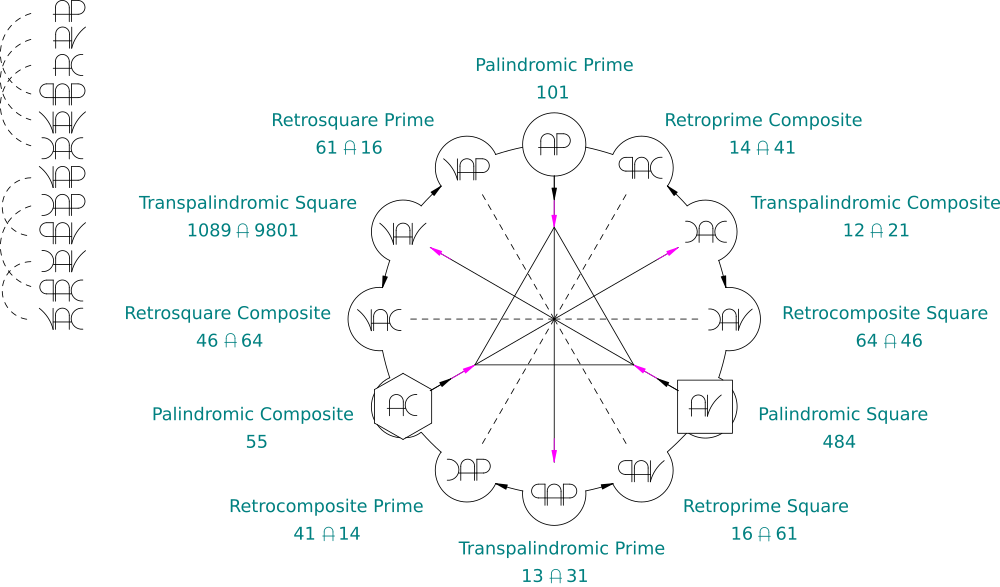| Term |
Definition |
| Multiple |
"Multiples" are all of the whole numbers formed when any number is multiplied repeatedly. For example, 10, 15, 20, 25, and so on, are all "multiples" of 5. In this case, it is like "skip counting" by fives. |
| Factor |
"Factors" are all of the whole numbers by which another number can be divided into without remainders. It is thus "divisible" by that number. For example, 3 and 5 are "factors" of 15 because 15 ÷ 3 = 5 and 15 ÷ 5 = 3. So, 15 is divisible by both 5 and 3. |
| Even Numbers |
"Even Numbers" are all of the whole numbers that are divisible by 2. The last digit of such numerals is always 0, 2, 4, 6, or 8. |
| Odd Numbers |
"Odd Numbers" are all of the whole numbers that are not divisible by 2. The last digit of such numerals is always 1, 3, 5, 7, or 9. |
| Perfect Numbers |
"Perfect Numbers" are all whole numbers whose factors add together to form that number. For example, 6 is the first perfect number because:
6 is divisible by 1, 2, and 3
and
1 + 2 + 3 = 6 |
| Glyphs |
Meaning |
 |
"Square Numbers" are the whole numbers formed by multiplying a whole number by itself. This is symbolized by a small number 2 to the upper right called an "exponent". For example:
12 = 1 × 1 = 1,
22 = 2 × 2 = 4,
32 = 3 × 3 = 9,
etc.
Therefore, the numbers 1, 4, and 9 are "Squares". |
 |
"Prime Numbers" are the whole numbers that only have factors of themselves and 1. They can't be divided into equal groups by any other whole number. For example, some of the smallest "Primes" are 2, 3, 5, 7, 11, 13, etc. Other than the number 2, they are always an odd number. |
 |
"Composite Numbers" are the whole numbers that have more factors than just themselves and 1. They can be thought of as almost like the opposite of a Prime, but they can be either even or odd. For example, 12 is "Composite" because it has many factors (1, 2, 3, 4, 6, and 12).
There are also "Highly Composite Numbers", which are the whole numbers that have more factors than any number coming before them. For example, the first few Highly Composite Numbers are 1, 2, 4, 6, 12, 24, 36, 48, 60, etc. |
| Term |
Definition |
| Palindromic |
A "palindrome" is something that is the same forwards and backwards. The number itself does not change when mirrored. These are also sometimes referred to as Binomial Reflection Numbers. |
| Transpalindromic |
The prefix "trans~" means "beyond, across, or through". Therefore, this name literally means something like "this number's properties are beyond mirroring". In other words, while the number itself changes, the type of number it is does not. These are also sometimes referred to as Transbinomial Reflection Numbers. |
| Retro~ |
The prefix "retro~" means "backward, reverse". Therefore, the properties of any type of number which has this prefix appended to its name, will change when mirrored. |
| Glyphs |
Meaning |
 |
Palindromic Prime - A number that is both Palindromic and Prime. [Example: 101] |
 |
Transpalindromic Prime - A number that is Prime both forward and backward. [Example: 13 is Prime, and its mirror, 31, is also Prime.] |
 |
Palindromic Square - A number that is both Palindromic and Square. [Example: 484 is 22 × 22] |
 |
Transpalindromic Square - A number that is Square both fowards and backwards. [Example: 1089 is 33 × 33, 9801 is 99 × 99, and both are mirrors of one another.] |
 |
Palindromic Composite - A number that is both Palindromic and Composite. [Example: 55] |
 |
Transpalindromic Composite - A number that stays Composite when mirrored. [Example: 12 is Composite, and 21, its reverse, is also Composite.] |
 |
Retrosquare Prime - A number that begins as Prime and becomes Square upon mirroring. [Example: 61 is Prime, while its reversal, 16, is Square, 4 × 4.] |
 |
Retroprime Square - A number that begins as Square and becomes Prime upon mirroring. The inverse of the above number class. |
 |
Retrocomposite Prime - A number that begins as a Prime number and becomes Composite when reversed. [Example: 41 is Prime, but 14, its mirror, is Composite.] |
 |
Retroprime Composite - A number that begins as a Composite but becomes a Prime when mirrored. The inverse of the above number class. |
 |
Retrocomposite Square - A number that is a Square and becomes Composite upon mirroring. [Example: 64 is 8 × 8, a Square, and its mirror, 46, is Composite.] |
 |
Retrosquare Composite - A number that is Composite and becomes Square upon mirroring. The inverse of the above number class. |
















